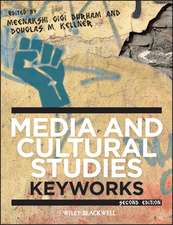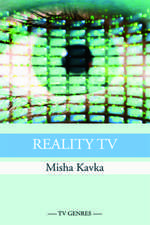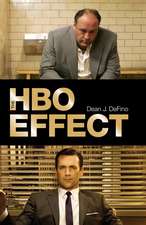Television and the Second Screen: Interactive TV in the age of social participation
Autor James Blakeen Limba Engleză Hardback – 27 oct 2016
James Blake examines interactive television from three crucial angles: audience motivation and agency, advances in TV production and the monetisation of second screen content. He also tracks its evolution by bringing together interviews with more than 25 television industry professionals - across the major UK channels - including commissioning editors, digital directors, producers and advertising executives. These reveal the successes and failures of recent experiments and the innovations in second screen projects.
As the second screen becomes second nature for viewers and producers, the risks and opportunities for the future of television are slowly beginning to emerge. Television and the Second Screen will offer students and scholars of television theory, industry professionals and anyone with an abiding interest in television and technology, an accessible and illuminating guide to this important cultural shift.
| Toate formatele și edițiile | Preț | Express |
|---|---|---|
| Paperback (1) | 238.40 lei 6-8 săpt. | |
| Taylor & Francis – 25 oct 2016 | 238.40 lei 6-8 săpt. | |
| Hardback (1) | 765.77 lei 6-8 săpt. | |
| Taylor & Francis – 27 oct 2016 | 765.77 lei 6-8 săpt. |
Preț: 765.77 lei
Preț vechi: 1103.70 lei
-31% Nou
Puncte Express: 1149
Preț estimativ în valută:
146.53€ • 153.30$ • 121.72£
146.53€ • 153.30$ • 121.72£
Carte tipărită la comandă
Livrare economică 02-16 aprilie
Preluare comenzi: 021 569.72.76
Specificații
ISBN-13: 9781138914322
ISBN-10: 1138914320
Pagini: 206
Ilustrații: 7
Dimensiuni: 156 x 234 mm
Greutate: 0.54 kg
Ediția:1
Editura: Taylor & Francis
Colecția Routledge
Locul publicării:Oxford, United Kingdom
ISBN-10: 1138914320
Pagini: 206
Ilustrații: 7
Dimensiuni: 156 x 234 mm
Greutate: 0.54 kg
Ediția:1
Editura: Taylor & Francis
Colecția Routledge
Locul publicării:Oxford, United Kingdom
Cuprins
List of illustrations
Acknowledgements
Introduction
1. The evolution of interactive TV
2. Recasting the active audience
3. Entertaining the interactive user: play-along, voting and gossip
4. Participating in the news agenda
5. Factual television: Reinventing the digital public space
6. Second screen as multi-platform transmedia storytelling
7. Monetising second screen gameplay
8. Advertising: "Disruption is at a maximum!"
9. The future for social participation in TV
Index
Acknowledgements
Introduction
1. The evolution of interactive TV
2. Recasting the active audience
3. Entertaining the interactive user: play-along, voting and gossip
4. Participating in the news agenda
5. Factual television: Reinventing the digital public space
6. Second screen as multi-platform transmedia storytelling
7. Monetising second screen gameplay
8. Advertising: "Disruption is at a maximum!"
9. The future for social participation in TV
Index
Recenzii
Very focused, topical, taps into a number of very interesting dynamics around television and social media. Hits all the key issues and has a good combination of practical case studies with wider conceptual trends and debates… It would be supplementary – it would best suit courses in broadcast journalism. – Charlie Beckett, LSE, UK
The book’s topic and object of study are extremely relevant and timely. Little research has been done (or has been published yet) on the use of second screen in relation to television watching... Depending on how the research for the proposed textbook is conducted (Which key figures are interviewed? What knowledge is made accessible?), it promises to provide highly needed input in the field... I would definitely be interested in considering a book on this topic for a course. – Jaap Kooijman, University of Amsterdam, The Netherlands
There is, at present very little recognised peer-reviewed research which has been carried out and published into this subject...The proposal is a timely one...I would consider this a supplementary text for my course, but would recommend it to colleagues in Film and Television, Media Communications and Advertising as an essential text. - Russell Merryman, London College of Communication, UK
The book’s topic and object of study are extremely relevant and timely. Little research has been done (or has been published yet) on the use of second screen in relation to television watching... Depending on how the research for the proposed textbook is conducted (Which key figures are interviewed? What knowledge is made accessible?), it promises to provide highly needed input in the field... I would definitely be interested in considering a book on this topic for a course. – Jaap Kooijman, University of Amsterdam, The Netherlands
There is, at present very little recognised peer-reviewed research which has been carried out and published into this subject...The proposal is a timely one...I would consider this a supplementary text for my course, but would recommend it to colleagues in Film and Television, Media Communications and Advertising as an essential text. - Russell Merryman, London College of Communication, UK
Descriere
Television is changing almost beyond recognition. In the battle for consumers, social media sites, smart phones and tablets have become rivals to traditional linear TV. However, audiences and producers are also embracing mobile platforms to enhance TV viewing itself. This book examines the emerging phenomenon of the Second Screen: where users are increasingly engaging with content on two screens concurrently. The practice is transforming television into an interactive, participatory and social experience.
In researching this work, James Blake has interviewed more than 25 people in the TV industry - across the major UK channels - including commissioning editors, digital directors, producers and advertising executives. In doing so, he has been able to track the evolution of interactive TV and examine the successes and failures of recent experiments and innovations in second screen projects.
Television and the Second Screen offers students and scholars of television theory and practice an accessible and illuminating guide to this important cultural shift.
In researching this work, James Blake has interviewed more than 25 people in the TV industry - across the major UK channels - including commissioning editors, digital directors, producers and advertising executives. In doing so, he has been able to track the evolution of interactive TV and examine the successes and failures of recent experiments and innovations in second screen projects.
Television and the Second Screen offers students and scholars of television theory and practice an accessible and illuminating guide to this important cultural shift.













